

Design-based research methods LINKS AND RESOURCES. Wang, S.

-K., Hsu, H. -Y., Reeves, T.C., & Coster, D.C. (2014). Professional development to enhance teachers' practices in using information and communication technologies (ICTs) as cognitive tools: Lessons learned from a design-based research study. Author of Moonwalking with Einstein. Research. Learning Theories.
Engaging Students with Game-Based Learning. 2014-horizon-he-preview.pdf (application/pdf Object) How to get Started Using Online Qualitative Research Methods. About 15 years ago, asynchronous online qualitative research began to appear as a new research methodology.
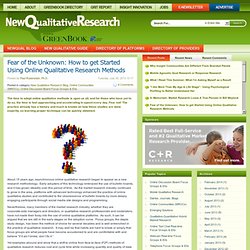
Early adopters of this technology embraced the use of bulletin boards, and it has grown steadily over this period of time. As the market research industry continued to grow in the area, platforms with advanced technology enhanced the practice of online qualitative studies and contributed to the obsolescence of bulletin boards by more deeply engaging participants through social media site designs and programming.
Nevertheless, many members of the market research industry, whether they are corporate-side managers and directors, or qualitative research professionals and moderators, have not made their foray into the use of online qualitative platforms. As such, it can be argued that we are still in the early stages on the adoption curve. One need not shift from the traditional focus group project to a complete and exclusively online qualitative study design. Leadership Through Instructional Design in Higher Education.
MOOCs and online learning: Research roundup. (iStock) The potential of MOOCs — massive open online courses — to provide educational access to all has generated significant interest and no shortage of hype.
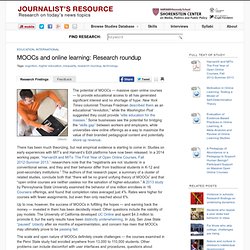
New York Times columnist Thomas Friedman described them as an educational “revolution,” while the Washington Post suggested they could provide “elite education for the masses.” Some businesses see the potential for bridging the “skills gap” between workers and employers, while universities view online offerings as a way to maximize the value of their branded pedagogical content and potentially shore up revenue. There has been much theorizing, but real empirical evidence is starting to come in. Studies on early experiences with MIT’s and Harvard’s EdX platforms have now been released. Up to now, however, the success of MOOCs in fulfilling the hopes — and earning back the money — invested in them has been decidedly mixed. A Visual Primer On Learning Theory. Theories on how people learn are not new.
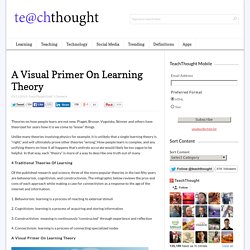
TooFAST VERSION 2.0. Doggett.pdf (application/pdf Object) » Learning Trends, Technologies, and Opportunities – New White Paper by Sharon Boller. Sharon Boller, President of Bottom-Line Performance, has authored a new white paper: “Learning Trends, Technologies and Opportunities.”
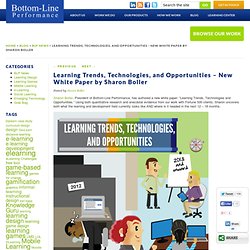
Using both quantitative research and anecdotal evidence from our work with Fortune 500 clients, Sharon uncovers both what the learning and development field currently looks like AND where is it headed in the next 12 – 18 months. Click the image to download the white paper! We talked a whole lot about mobile learning in 2012, but lots of companies have not even started implementing mobile learning on a large scale. Footprints of emergence. Roy Trevor Williams (1), Jenny Mackness (2), and Simone Gumtau (1) (1) University of Portsmouth, United Kingdom, (2) Independent Consultant, United Kingdom Abstract It is ironic that the management of education has become more closed while learning has become more open, particularly over the past 10-20 years.
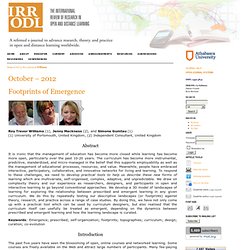
The curriculum has become more instrumental, predictive, standardized, and micro-managed in the belief that this supports employability as well as the management of educational processes, resources, and value. 1321 (application/pdf Object) Vol 12, No 7 (2011) Emergent learning and learning ecologies in Web 2.0. Special Issue - Connectivism: Design and Delivery of Social Networked Learning Roy Williams University of Portsmouth, UK Regina Karousou Independent Educational Researcher, UK Jenny Mackness Independent Education Consultant, UK Abstract This paper describes emergent learning and situates it within learning networks and systems and the broader learning ecology of Web 2.0.

The paper argues that although social networking media increase the potential range and scope for emergent learning exponentially, considerable effort is required to ensure an effective balance between openness and constraint. 1650 (application/pdf Object) EbertMay et al_2011.pdf (application/pdf Object) Using Learning Analytics to Evaluate the Effectiveness of Faculty Development. Andresen: Asynchronous discussion forums: success...
About this page Our systems have detected unusual traffic from your computer network.
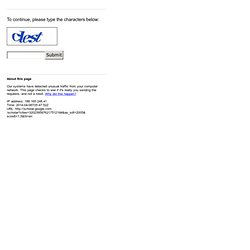
This page checks to see if it's really you sending the requests, and not a robot. Why did this happen? This page appears when Google automatically detects requests coming from your computer network which appear to be in violation of the Terms of Service. The block will expire shortly after those requests stop. This traffic may have been sent by malicious software, a browser plug-in, or a script that sends automated requests. Sometimes you may be asked to solve the CAPTCHA if you are using advanced terms that robots are known to use, or sending requests very quickly. IP address: 188.165.248.41Time: 2014-04-08T05:47:52ZURL: Changing Course: Ten Years of Tracking Online Education in the United States. The tenth annual survey, a collaborative effort between the Babson Survey Research Group and the College Board, is the leading barometer of online learning in the United States.
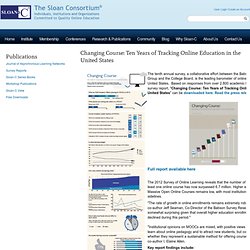
Based on responses from over 2,800 academic leaders, the complete survey report, "Changing Course: Ten Years of Tracking Online Education in the United States" can be downloaded here. Read the press release Full report available here The 2012 Survey of Online Learning reveals that the number of students taking at least one online course has now surpassed 6.7 million. Higher education adoption of Massive Open Online Courses remains low, with most institutions still on the sidelines. "The rate of growth in online enrollments remains extremely robust," said study co-author Jeff Seaman, Co-Director of the Babson Survey Research Group. Key report findings include: Previously underwritten by the Alfred P. Pearltrees.
Free #research papers on #mLearning from mLearn conference. Kiriakidis2008.pdf (application/pdf Object)